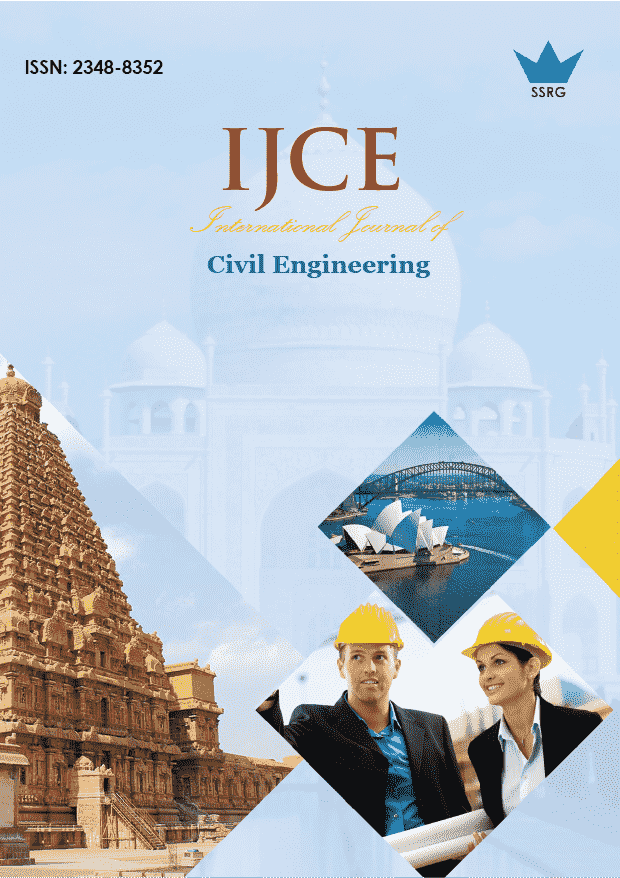Optimizing Parking Dynamics in Urban Areas: A Mathematical Model for Pune, Maharashtra

| International Journal of Civil Engineering |
| © 2025 by SSRG - IJCE Journal |
| Volume 12 Issue 2 |
| Year of Publication : 2025 |
| Authors : Anuradha Anil Pore, Pravin D. Nemade, Shobha Rani Nadupuru |
How to Cite?
Anuradha Anil Pore, Pravin D. Nemade, Shobha Rani Nadupuru, "Optimizing Parking Dynamics in Urban Areas: A Mathematical Model for Pune, Maharashtra," SSRG International Journal of Civil Engineering, vol. 12, no. 2, pp. 1-6, 2025. Crossref, https://doi.org/10.14445/23488352/IJCE-V12I2P101
Abstract:
The absence of parking spaces and the resulting urban congestion are the two more significant problems in rapidly urbanizing places like Pune and Maharashtra. The current parking problems, which are brought on by the fast increase in the number of automobiles, result in heavy traffic, a shortage of space, and decreased mobility. This work proposes a mathematical approach to address these issues by combining adaptive parking capacity and dynamic pricing, which increases parking capacity while lowering traffic. In order to create a model that can decrease traffic and increase parking efficiency, real data was gathered from the busiest parts of the Pune region, including the study area, J.M. Road. According to the developed model, adaptive capacity can minimize congestion by up to 20% during peak hours, while dynamic pricing aids in supply and demand balance. Legislators and urban planners may find these findings helpful in creating more efficient parking structures that support enhanced mobility, smoother traffic flow, and sustainable urban growth. The suggested mathematical model updates Pune's parking infrastructure, which adds to the city's growing urbanization.
Keywords:
Parking optimization, Urban congestion, Adaptive capacity, Dynamic pricing, Traffic management.
References:
[1] Donald Shoup, High Cost of Free Parking, Taylor and Francis, 1st ed., pp. 1-752, 2005.
[Google Scholar] [Publisher Link]
[2] Richard Arnott, and John Rowse, “Curbside Parking Time Limits,” Transportation Research Part A: Policy and Practice, vol. 55, pp. 89-110, 2013.
[CrossRef] [Google Scholar] [Publisher Link]
[3] Gregory Pierce, and Donald Shoup, “Getting the Prices Right,” Journal of the American Planning Association, vol. 79, no. 1, pp. 67-81, 2013.
[CrossRef] [Google Scholar] [Publisher Link]
[4] Changxi Ma, Xiaoting Huang, and Jiangchen Li, “A Review of Research on Urban Parking Prediction,” Journal of Traffic and Transportation Engineering (English Edition), vol. 11, no. 4, pp. 700-720, 2024.
[CrossRef] [Google Scholar] [Publisher Link]
[5] Camila Florez Bossio, James Ford, and Danielle Labbe, “Adaptive Capacity in Urban Areas of Developing Countries,” Climatic Change, vol. 157, pp. 279-297, 2019.
[CrossRef] [Google Scholar] [Publisher Link]
[6] Janak Parmar et al., “Evaluation of Parking Characteristics: A Case Study of Delhi,” Transportation Research Procedia, vol. 48 pp. 2744-2756, 2020.
[CrossRef] [Google Scholar] [Publisher Link]
[7] Ruby Singh et al., “An Improved Vehicle Parking Mechanism to Reduce Parking Space Searching Time using Firefly Algorithm and Feed Forward Back Propagation Method,” Procedia Computer Science, vol. 167, pp. 952-961, 2020.
[CrossRef] [Google Scholar] [Publisher Link]
[8] Abdul Ahad, and Farhan A. Kidwai, “Comprehensive Analysis of Urban Vehicle Parking Challenges: A Comprehensive Survey of Delhi,” International Journal of Creative Research Thoughts, vol. 11, no. 12, pp. c649- c657, 2023.
[Publisher Link]
[9] Sejal S. Bhagat, Er. Manoj L. Patel, and Er. Palak S. Shah, “Pedestrian Priority in Urban Area and Usefulness towards Community,” International Journal of Research in Engineering and Technology, vol. 3, no. 1, pp. 526-530, 2014.
[CrossRef] [Google Scholar] [Publisher Link]
[10] Abdul Razak Ali, and Sitti Asmah Hassan, “Review of Malaysian Current Practice in Supply/Demand of Parking in the Hospital,” IOP Conference Series: Materials Science and Engineering: 10th Malaysian Road Conference and Exhibition, Selangor, Malaysia vol. 512, pp. 1-7, 2019.
[Google Scholar] [Publisher Link]
[11] Biruk Gebremedhin Mesfin et al., “Urban Traffic-Parking System Dynamics Model with Macroscopic Properties: A Comparative Study between Shanghai and Zurich,” Humanities and Social Sciences Communications, vol. 11, no. 1, pp. 1-13, 2024.
[CrossRef] [Google Scholar] [Publisher Link]
[12] Janak Parmar, Pritikana Das, and Sanjaykumar M. Dave, “Study on Demand and Characteristics of Parking System in Urban Areas: A Review,” Journal of Traffic and Transportation Engineering (English Edition), vol. 7, no. 1, pp. 111-124, 2020.
[CrossRef] [Google Scholar] [Publisher Link]
[13] William Young, Russell G. Thompson, and Michael A.P. Taylor, “A Review of Urban Car Parking Models,” Transport Reviews, vol. 11, no. 1, pp. 63-84, 1991.
[CrossRef] [Google Scholar] [Publisher Link]
[14] Qing Shen, “Urban Transportation in Shanghai, China: Problems and Planning Implications,” International Journal of Urban and Regional Research, vol. 21, no. 4, pp. 589-606, 1997.
[CrossRef] [Google Scholar] [Publisher Link]
[15] Ministry of Road Transport and Highways, Annual Reports, 2014-2020. [Online]. Available: https://morth.nic.in/annual-report
[16] Government of India, Ministry of Road Transport and Highways, Transport Reesrach Wing, Road transport year Book (2019-20), 2023. [Online]. Available: https://morth.nic.in/sites/default/files/RTYB_Publication_2019_20%20(1).pdf
[17] Development Control and Promotion Regulations for Pune Municipal Corporation (DCPR-2017), Development Plans, Pune Municipal Corporation (PMC), pp. 1-231, 2017. [Online]. Available: https://pmc.gov.in/sites/default/files/DC%20Rul%202017.PDF
[18] IRC: SP:12-2015: Guidelines for Parking Facilities in Urban Areas, Indian Road Congress, 1-52, 2015. [Online]. Available: https://law.resource.org/pub/in/bis/irc/irc.gov.in.sp.012.2015.pdf

 10.14445/23488352/IJCE-V12I2P101
10.14445/23488352/IJCE-V12I2P101